CHEVROLET CORVETTE 1996 4.G Owners Manual
Manufacturer: CHEVROLET, Model Year: 1996, Model line: CORVETTE, Model: CHEVROLET CORVETTE 1996 4.GPages: 386, PDF Size: 20.12 MB
Page 131 of 386
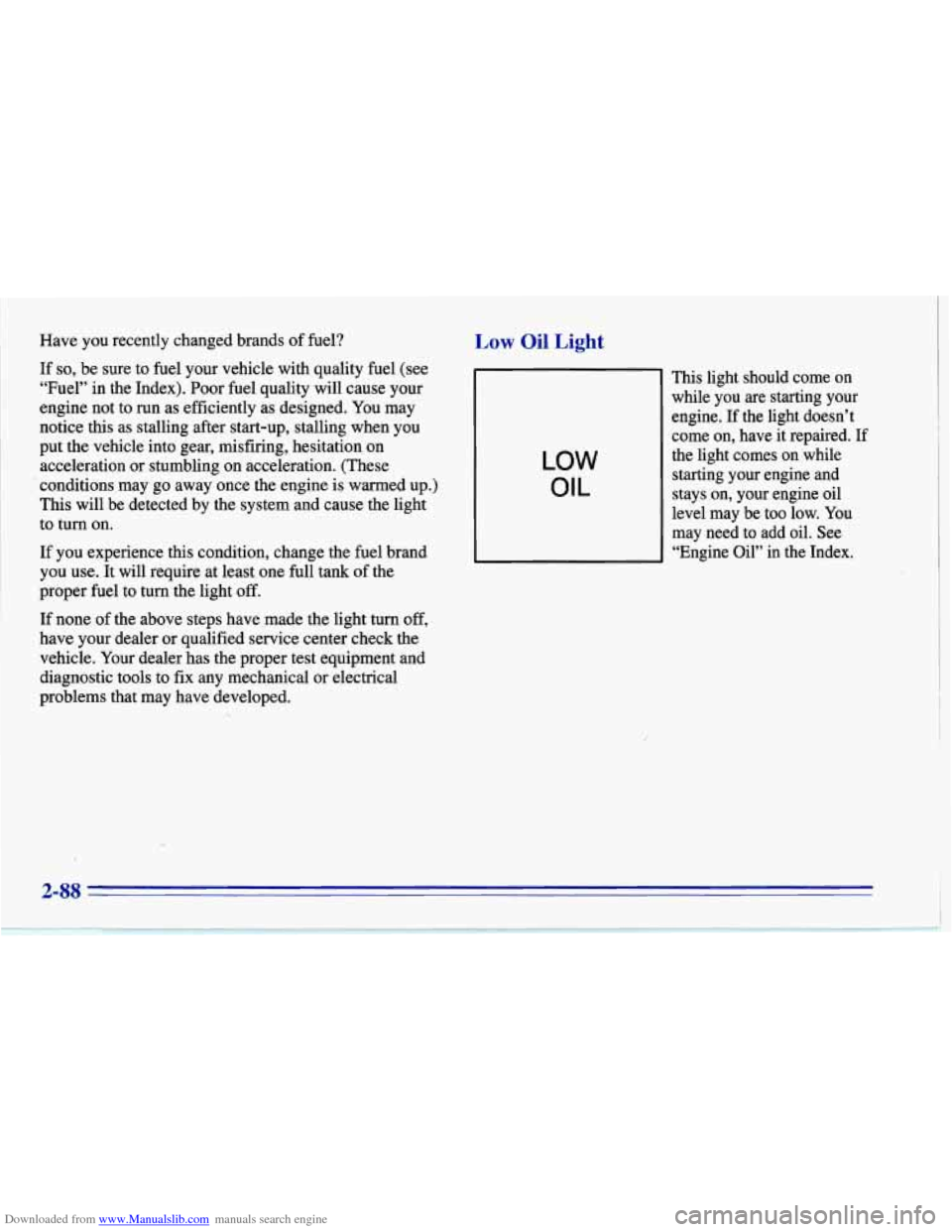
Downloaded from www.Manualslib.com manuals search engine Have you recently changed brands of fuel?
If so, be sure to fuel your vehicle with quality fuel (see
“Fuel” in the Index). Poor
fuel quality will cause your
engine not to run as efficiently as designed.
You may
notice this as stalling after start-up, stalling when you
put the vehicle into gear, misfiring, hesitation on
acceleration or stumbling on acceleration. (These
conditions may go away once the engine is warmed up.)
This will be detected by the system and cause the light
to turn on.
If you experience this condition, change the fuel brand
you use. It will require at least one full tank of the
proper fuel to turn the light
off.
If none of the above steps have made the light turn off,
have your dealer or qualified service center check the
vehicle. Your dealer has the proper test equipment and
diagnostic tools to fix any mechanical or electrical
problems that may have developed.
Low Oil Light
LOW
OIL
This light should come on
while you are starting your
engine.
If the light doesn’t
come on, have it repaired. If
the light comes on while
starting your engine and
stays on, your engine oil
level may be too low.
You
may need to add oil. See
“Engine Oil” in the Index.
2-88
Page 132 of 386
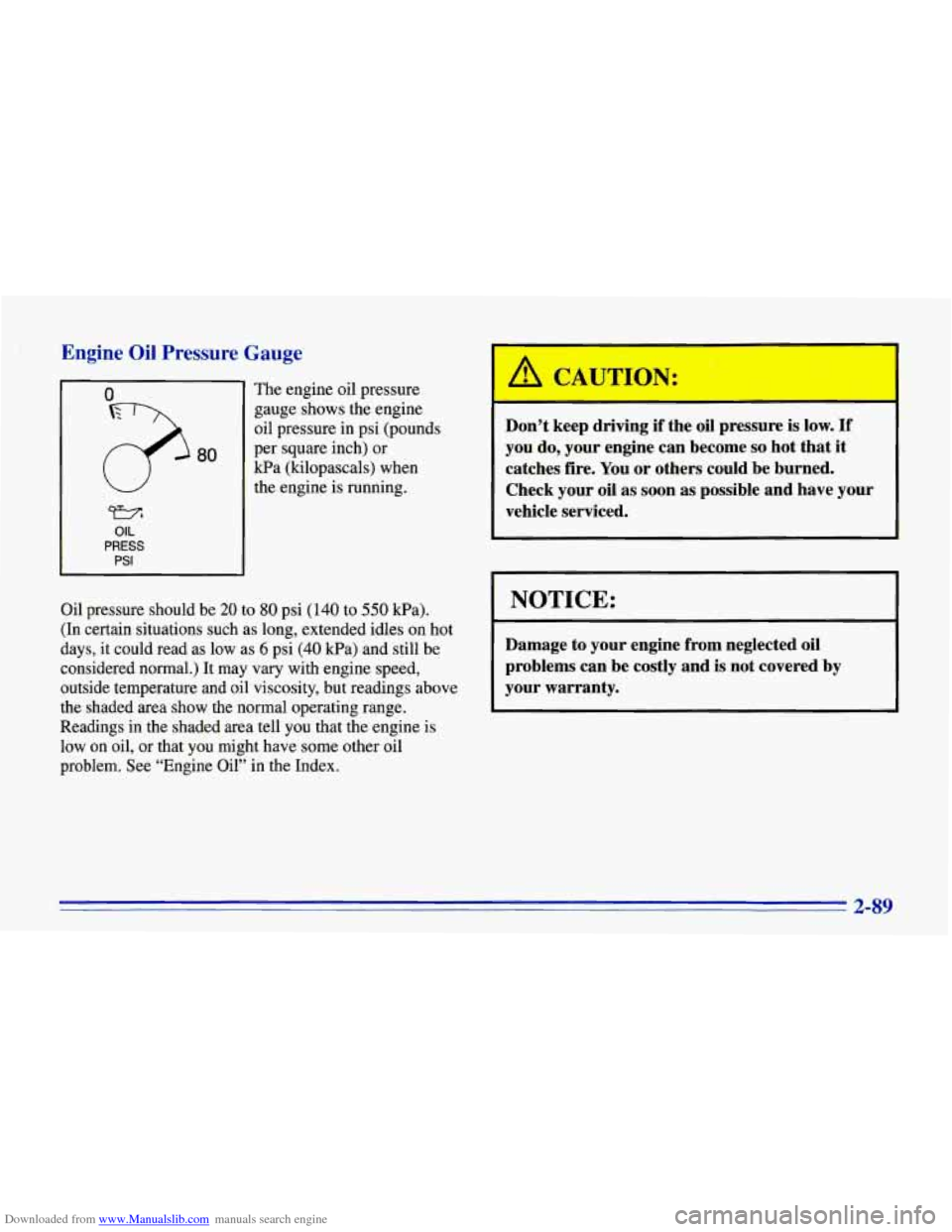
Downloaded from www.Manualslib.com manuals search engine Engine Oil Pressure Gauge
0
WA
OIL
PRESS
PSI
The engine oil pressure
gauge shows the engine
oil pressure in psi (pounds
per square inch) or
kPa (kilopascals) when
the engine is running.
Oil pressure should be
20 to 80 psi (140 to 550 Wa).
(In certain situations such as long, extended idles on hot
days, it could read as low as
6 psi (40 kPa) and still be
considered normal.) It may
vary with engine speed,
outside temperature and oil viscosity, but readings above
the shaded area show the normal operating range.
Readings in the shaded area tell you that the engine is
low on oil, or that you might have some other oil
problem. See “Engine Oil”
in the Index.
A CAUTIOh:
Don’t keep driving if the oil pressure is low. If
you do, your engine can become so hot that it
catches fire. You or others could be burned.
Check your oil as soon as possible and have your
vehicle serviced.
I 1
NOTICE:
Damage to your engine from neglected oil
problems can be costly and
is not covered by
your warranty.
2-89
Page 133 of 386
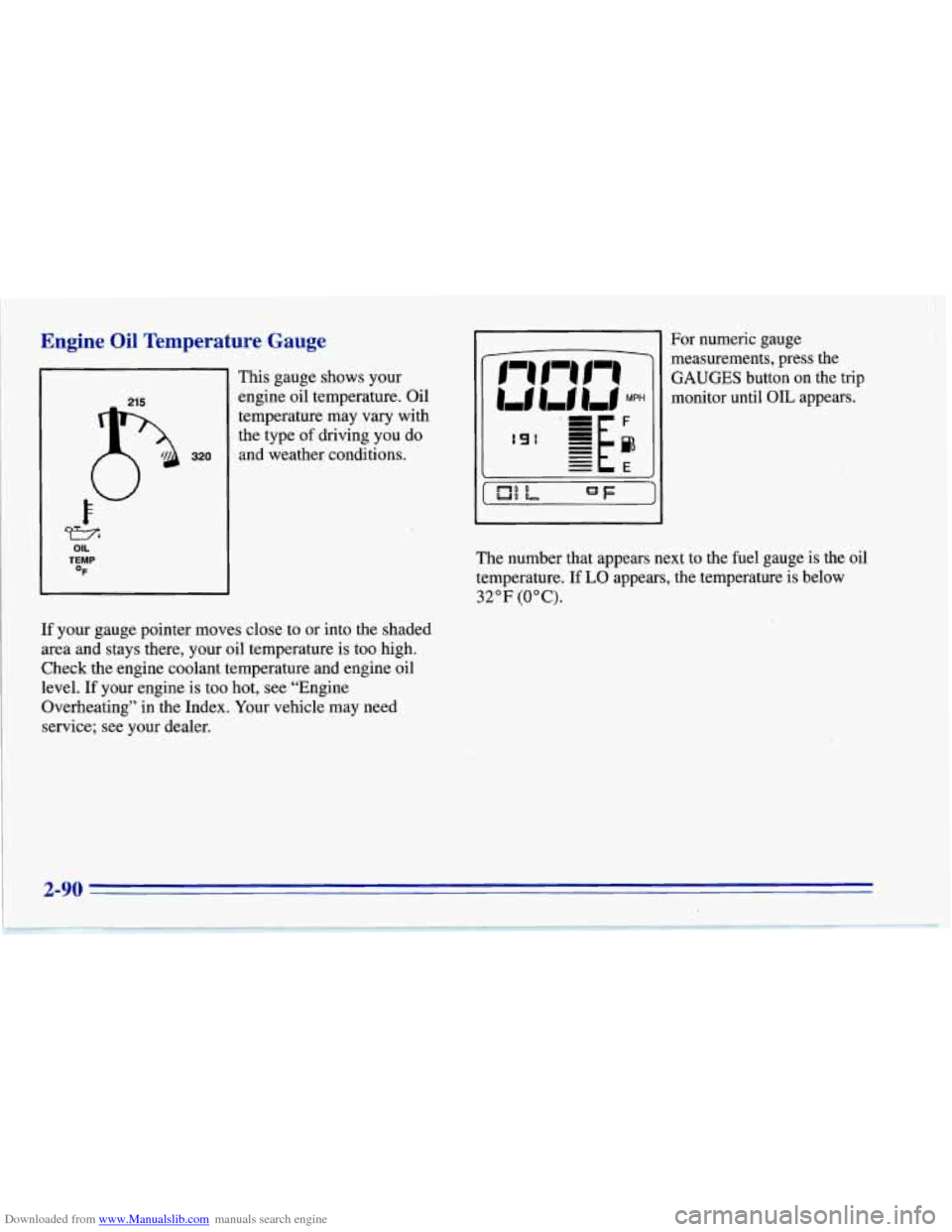
Downloaded from www.Manualslib.com manuals search engine Engine Oil Temperature Gauge
320
OIL TEMP OF
This gauge shows your
engine oil temperature. Oil
temperature may vary with
the type
of driving you do
and weather conditions.
If your gauge pointer moves close to or into the shaded
area and stays there, your oil temperature is too high.
Check the engine coolant temperature and engine oil
level.
If your engine is too hot, see “Engine
Overheating” in the Index. Your vehicle may need
service; see your dealer.
I,
For numeric gauge
measurements, press the GAUGES button on the trip
monitor until
OIL appears.
The number that appears next to the fuel gauge is the oil
temperature.
If LO appears, the temperature is below
32°F (OOC).
2-90
Page 134 of 386

Downloaded from www.Manualslib.com manuals search engine Engine Oil Life Monitor
CHANGE
OIL
The CHANGE OIL light
comes on for a few seconds
when you turn the ignition
on. It will come on and stay
on when it’s time to change
your oil.
The monitor uses oil temperature and engine revolutions
to decide when the oil
is nearly worn out. The light is
only a reminder, though. Be sure
to reset the monitor when your oil
is changed,
even
if the CHANGE OIL light didn’t come on. If you
don’t reset the monitor, it won’t work correctly. Follow
these steps:
1. Turn the key to RUN, but don’t start the engine.
2. Press ENG MET on the trip monitor. Then, within
five seconds, press it again.
3. Within five seconds, press and hold GAUGES on the
trip monitor. The CHANGE OIL light should flash.
4. Hold the GAUGES button until the CHANGE OIL
light stops flashing and goes out. This should take
about
10 seconds.
When the light goes out, the monitor is reset. If
the monitor doesn’t reset, turn the ignition off, then
try again.
2-91
Page 135 of 386
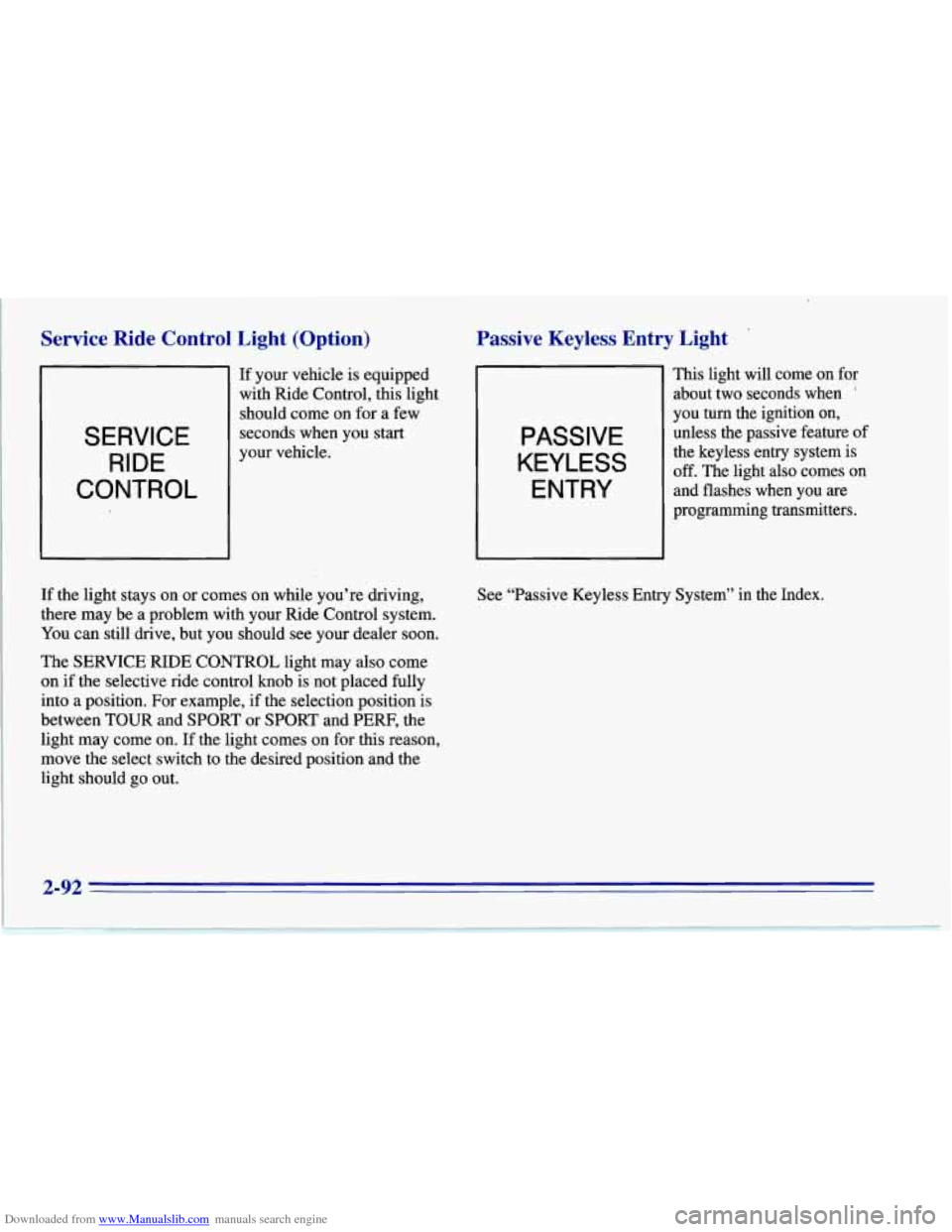
Downloaded from www.Manualslib.com manuals search engine Service Ride Control Light (Option)
SERVICE RIDE
CONTROL
If your vehicle is equipped
with Ride Control, this light
should come on for a few
seconds when you start
your vehicle.
If the light stays on or comes on while you’re driving,
there may be a problem with your Ride Control system.
You can still drive, but you should see your dealer soon.
The SERVICE RIDE CONTROL light may also come
on if the selective ride control
knob is not placed fully
into a position. For example, if the selection position is
between TOUR and SPORT
or SPORT and PERF, the
light may come on. If the light comes on for
this reason,
move the select switch
to the desired position and the
light should go out.
Passive Keyless Entry Light
PASSIVE
KEYLESS
ENTRY
This light will come on for
about two seconds when
’
you turn the ignition on,
unless the passive feature
of
the keyless entry system is
off. The light also comes on
and flashes when you are
programming transmitters.
See “Passive Keyless Entry System’’ in the Index.
2-92
Page 136 of 386
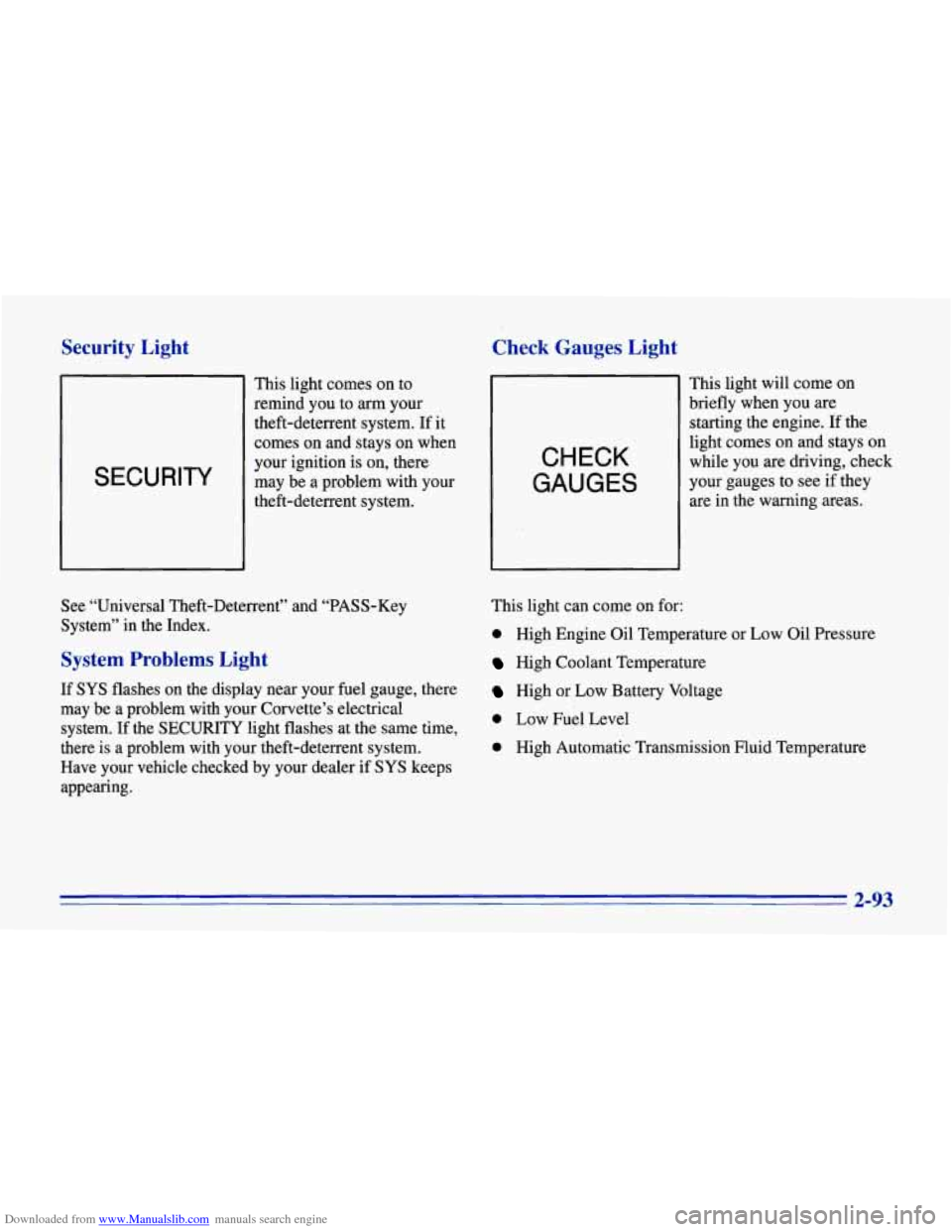
Downloaded from www.Manualslib.com manuals search engine Security Light Check Gauges Light
SECURITY
This light comes on to
remind you to
arm your
theft-deterrent system. If it
comes on and stays on when
your ignition is on, there
may be a problem with your
theft-deterrent system.
CHECK
GAUGES
This light will come on
briefly when you are
starting the engine.
If the
light comes on and stays on
while you are driving, check
your gauges to see if they
are in the warning areas.
See “Universal Theft-Deterrent” and “PASS-Key
System” in the Index.
System Problems Light
If SYS flashes on the display near your fuel gauge, there
may be a problem with your Corvette’s electrical
system. If the
SECURITY light flashes at the same time,
there is
a problem with your theft-deterrent system.
Have your vehicle checked by your dealer
if SYS keeps
appearing. This
light can come on for:
0 High Engine Oil Temperature or Low oil Pressure
High Coolant Temperature
High or Low Battery Voltage
0 Low Fuel Level
0 High Automatic Transmission Fluid Temperature
2-93
Page 137 of 386
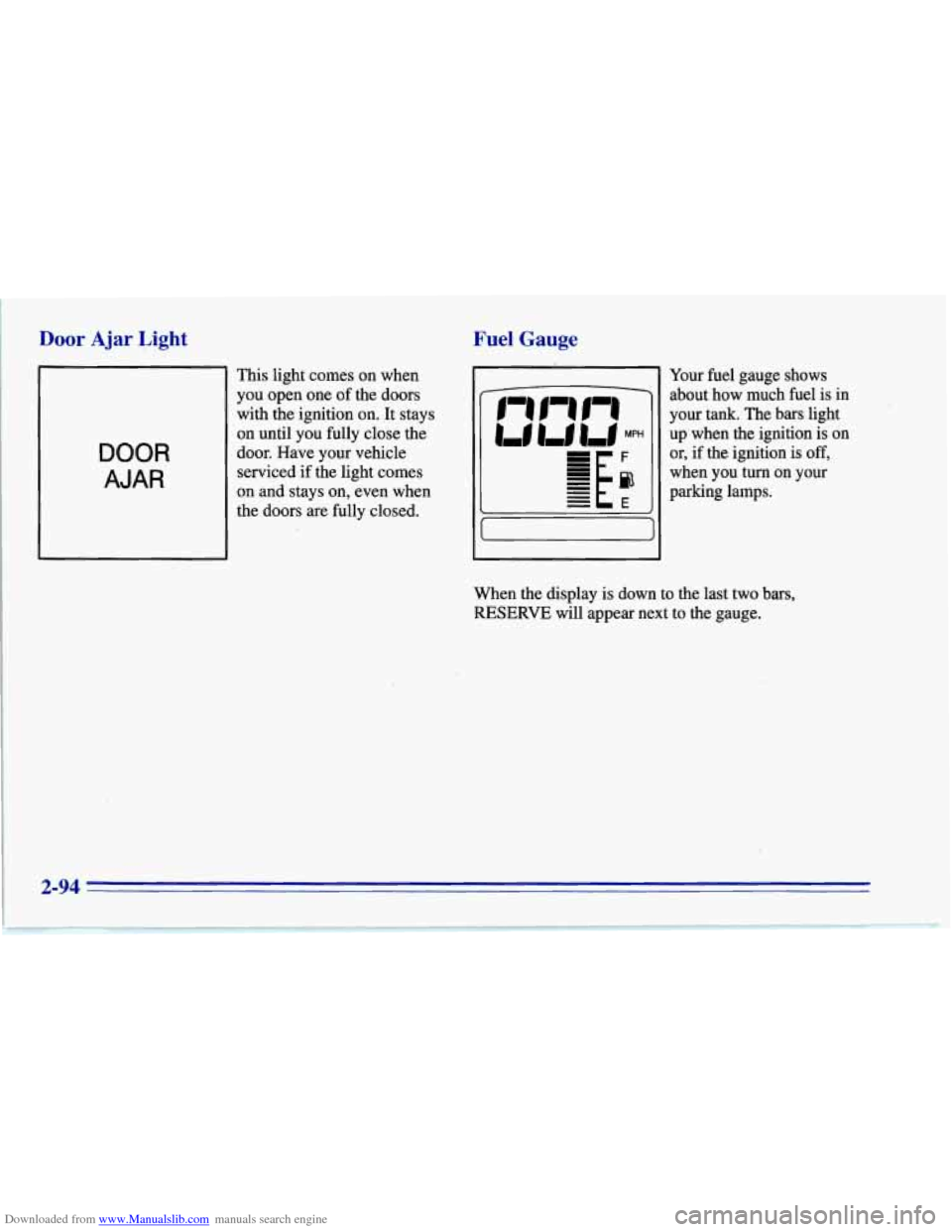
Downloaded from www.Manualslib.com manuals search engine Door Ajar Light
DOOR
AJAR
This light comes on when
you open one of the doors
with the ignition on. It stays
on until you fully close the
door. Have your vehicle
serviced if the light comes
on and stays on, even when
the doors are fully closed.
Fuel Gauge
Your fuel gauge shows
about how much fuel is in
your tank. The bars light
up'when the ignition is on
or, if the ignition is
off,
when you turn on your
parking lamps.
When the display is down to the last two bars,
RESERVE will appear next to the gauge.
2-94
Page 138 of 386
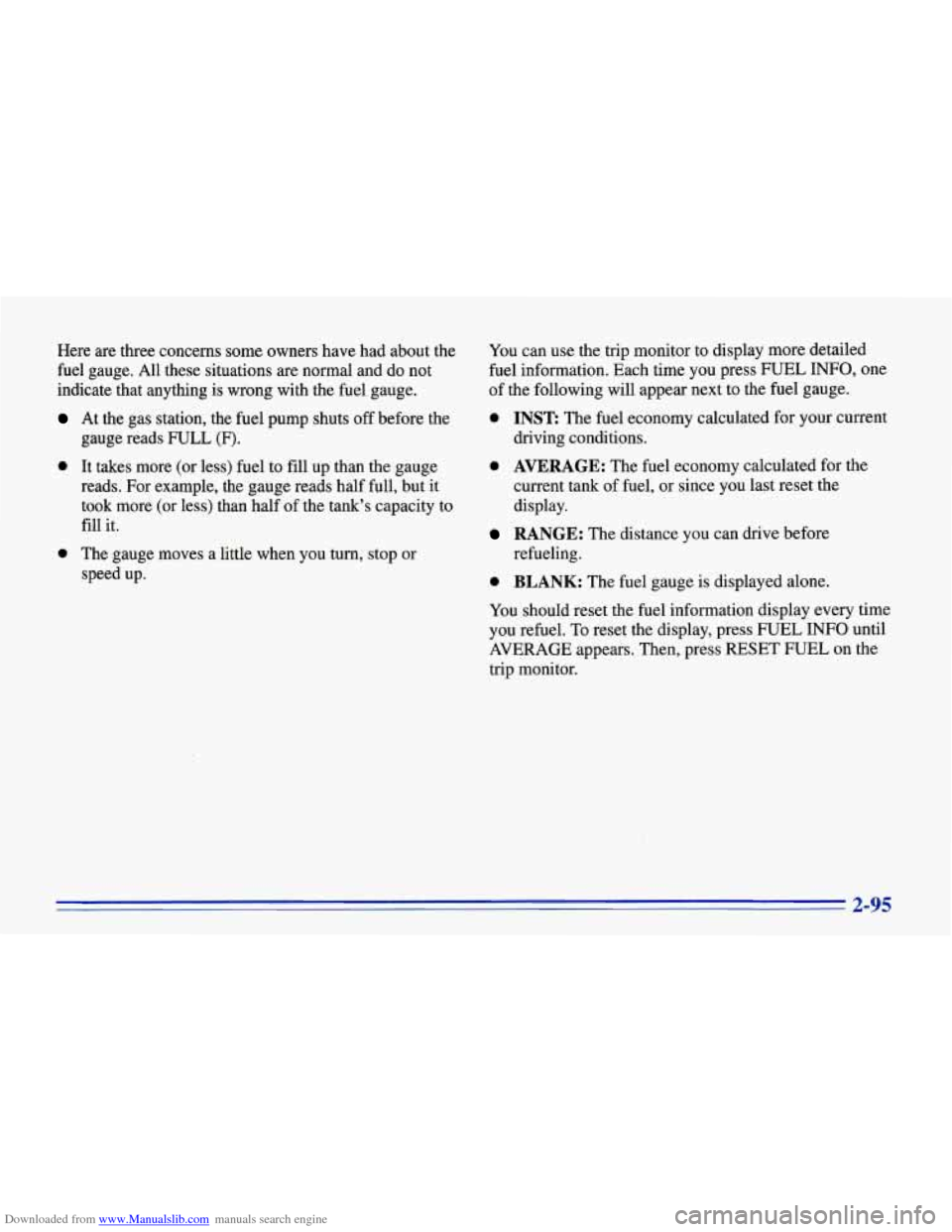
Downloaded from www.Manualslib.com manuals search engine Here are three concerns some owners have had about the
fuel gauge. All these situations are normal and do not
indicate that anything is wrong with the fuel gauge.
At the gas station, the fuel pump shuts off before the
gauge reads FULL (F).
0 It takes more (or less) fuel to fill up than the gauge
reads. For example,
the gauge reads half full, but it
took more (or less) than half of the tank’s capacity to
fill it.
0 The gauge moves a little when you turn, stop or
speed up. You
can use the trip monitor to display more detailed
fuel information. Each time you press FUEL
INFO, one
of the following will appear next to the fuel gauge.
0 INST: The fuel economy calculated for your current
driving conditions.
0 AVERAGE: The fuel economy calculated for the
current tank of fuel, or since you last reset the
display.
refueling.
RANGE: The distance you can drive before
0 BLANK: The fuel gauge is displayed alone.
You should reset the
fuel information display every time
you refuel. To reset the display, press FUEL
INFO until
AVERAGE appears. Then, press RESET FUEL on the
trip monitor.
2-95
Page 139 of 386
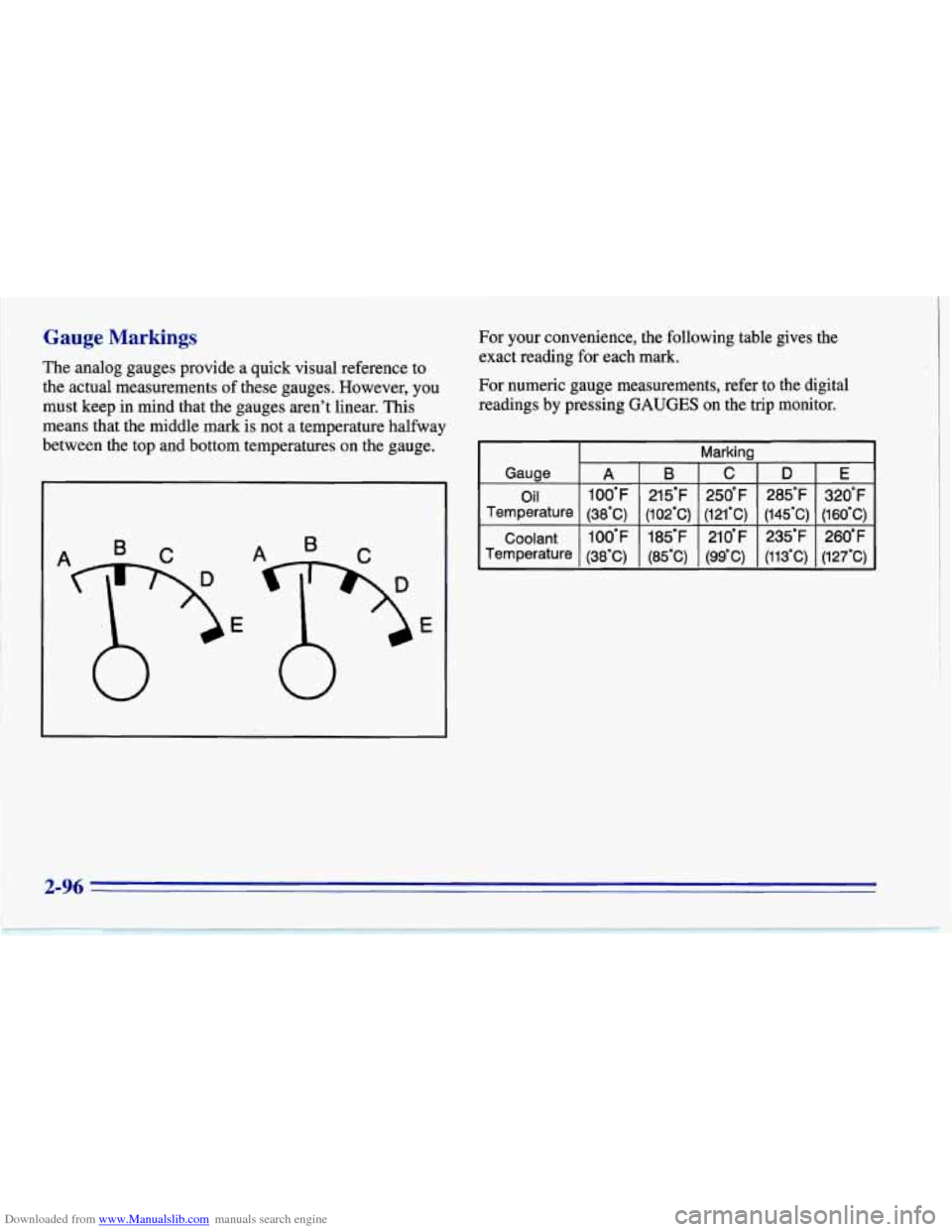
Downloaded from www.Manualslib.com manuals search engine Gauge Markings
The analog gauges provide a quick visual reference to
the actual measurements of these gauges. However, you
must keep in mind that the gauges aren't linear. This
means that the middle mark
is not a temperature halfway
between the top and bottom temperatures on the gauge.
1
E
A
p
E
J
For your convenience, the following table gives the
exact reading for each mark.
For numeric gauge measurements, refer to the digital
readings by pressing
GAUGES on the trip monitor.
Marking
Gauge
E
D C B A
Oil 320.F
285°F
250°F 215.F 100.F
Temperature
.(127'C) (113'C) (99'C) (85'C) (38'C) Temperature
260'F
235'F
210'F 185OF 100.F Coolant (160.C)
(145.C)
(121'C) (102OC)
(38-C)
2-96
Page 140 of 386
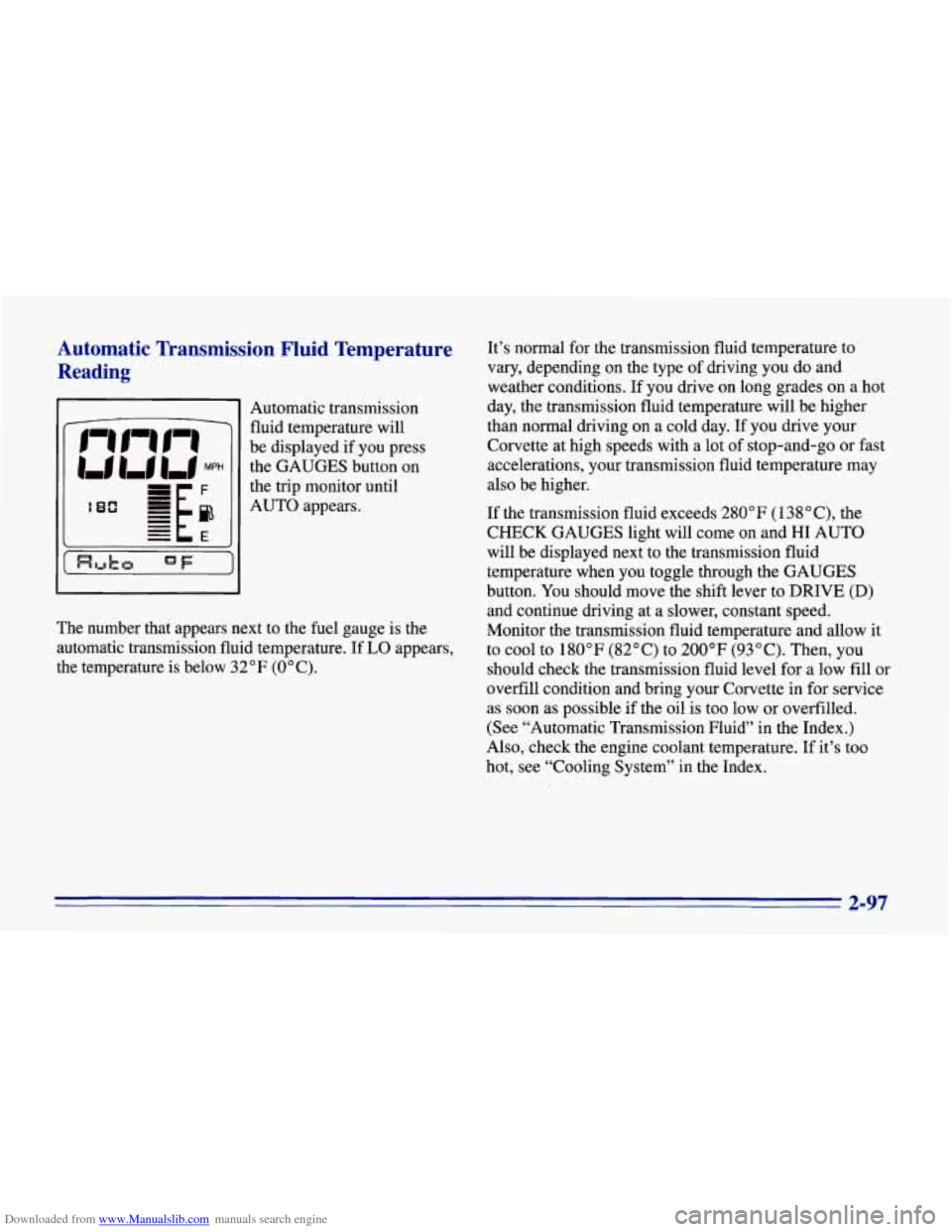
Downloaded from www.Manualslib.com manuals search engine Automatic Transmission Fluid Temperature Reading
Automatic transmission
fluid temperature will
be displayed if you press
the GAUGES button on
the trip monitor until
AUTO appears.
The number that appears next to the fuel gauge is the
automatic transmission fluid temperature. If
LO appears,
the temperature is below 32°F (0°C). It’s
normal for the transmission fluid temperature to
vary, depending on the type
of driving you do and
weather conditions. If you drive on long grades on a hot
day, the transmission fluid temperature will be higher
than normal driving on a cold day. If you
drive your
Corvette at high speeds with a lot of stop-and-go or fast
accelerations, your transmission fluid temperature may
also be higher.
If the transmission fluid exceeds
280” F (1 38 “C), the
CHECK GAUGES light will come on and HI AUTO
will be displayed next to the transmission fluid
temperature when you toggle through the GAUGES
button. You should move the shift lever to DRIVE
(D)
and continue driving at a slower, constant speed.
Monitor the transmission fluid temperature and allow it
to cool to 180°F (82°C) to 200°F (93°C). Then, you
should check the transmission fluid level for a low fill or
overfill condition and bring your Corvette in for service
as soon as possible if the oil is too low or overfilled.
(See “Automatic Transmission Fluid” in the Index.)
Also, check the engine coolant temperature. If it’s too
hot, see “Cooling System” in the Index.
2-97